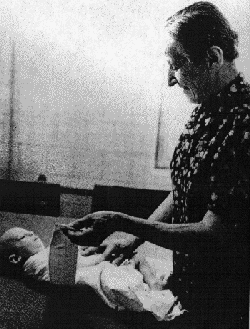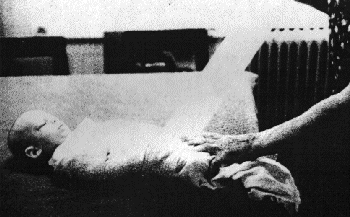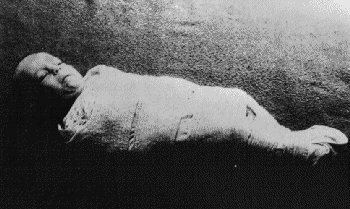
PSYCHOHISTORY
Articles & Texts
[Books texts] [Journal Articles] [Charts] [Prenatal]
[Trauma Model] [Cultic] [Web links] [Cartoons] [Other]
 |
Digital
Archive of PSYCHOHISTORY Articles & Texts [Books texts] [Journal Articles] [Charts] [Prenatal] [Trauma Model] [Cultic] [Web links] [Cartoons] [Other] |
The Gentle Revolution: Childhood Origins of Soviet and East European Democratic Movements
Lloyd deMause
The Journal of psychohistory 17(4). Spring 1990
Lloyd deMause
An eighteenth-century French visitor to Russia wrote the
following description in his diary of a traditional baptism
ceremony he had just attended:
Melissino and l were present at an extraordinary ceremony [on the
river Neva], then covered with five feet of ice.
After the benediction of the waters, children were baptized by
being plunged into a large hole which had been made in the ice.
On the day on which I was present the priest happened to let one
of the children slip through his hands.
"DRUGOIl" he cried. That is, "GIVE ME
ANOTHER." But my surprise may be imagined when I saw that
the father and mother of the child were in an ecstasy of joy;
they were certain that the babe had been carried straight to
heaven.[1]
The incident was typical of Russian childrearing practices until
well in-to this century-practices that were still medieval
compared to those of the West. Most Russian parents, for
instance, believed that subjecting in-fants to extreme heat and
cold properly "hardened" them and "weeded out the
unfit." As one English visitor reported:
The Muscovites [make] their children endure the ex-tremities of
heat and cold, hunger, thirst, and labour. They wash their
new-born infants in cold water, and roll them upon ice, and
amongst snow, which if they out-live not, their mothers think
them not worth a tear.[2]
Home baptism in ice water typically lasted for over an hour.
Lomonosov described one he witnessed in 1883:
the large stone hall of the parent's house in which the baptism
would occur was not heated for twenty-four hours [and] water was
taken directly from the well . . . the child cried out furiously
and did not cease screaming with his whole strength except for
short spells of breathing after complete immersion . . . the
child fell into an unconscious state [and] developed convulsions
and fever ...[3]
It is not surprising that until recently child mortality in
Russia was tri-ple that of Western Europe, with well over half of
all born dying during childhood.[4]
In Western Europe, such severely abusive childrearing practices
had gone out of style centuries earlier. Ice-water bathing, for
instance, had been a standard practice in all of Europe, but
began to be widely criticiz-ed during the eighteenth century.
While earlier diaries had often reported that newborns had
"Died of being baptized" in icewater[5] and doctors had
recommended daily icewater baths for children,[6] parents by the
end of the eighteenth century began to consider such
"hardening" practices unnecessarily severe. As one
wrote in 1797:
To see a little infant [washed] in cold water . . itself in one
continuous scream, and the fond mother covering her ears under
the bed-clothes that she may not be distressed by its cries has
ever struck me as a piece of unnecessary severity . . .[7]
In Russia, however, effective opposition to traditional abusive
childrearing practices did not begin until well into the
twentieth century. This two-century delay in childrearing reform
is the origin, I believe, of the two-century delay in political
reform in Russia as compared to the West. Furthermore, the vast
improvement in Soviet childrearing in recent decades has produced
the changes in Russian mentality and laid the groundwork for the
dramatic political changes that have been occurring in recent
months.
CHILDREARING REFORM AND POLITICAL REFORM
The central theme of my Psychohistorical studies during the past
two decades has been that childrearing reform has always preceded
political reform.
Russia provides a particularly dramatic test and proof of this
thesis. The political nightmares of Czarist and Stalinist Russia
were exact recreations of the nightmares of traditional Russian
childhood.[8] Widespread infanticide, severe beatings and other
physical abuse have been the models for the physical violence of
the Kremlin, the KGB and the Gulag. And what Nathan Leites calls
the traditional Russian per-sonality traits-their fears of
independence, their mood swings and their need for external
controls[9] -were all results of the long swaddling, emo-tional
abandonment and cold parenting that were widespread until
recently.[10] Just as infants who have been swaddled cry out for
their bindings when they are unbound - so used to restraint have
they become-so, too, adults who have been physically and
emotionally swaddled as children cry out for totalitarian
restraints in their political systems.
THE NIGHTMARES OF TRADITIONAL RUSSIAN CHILDHOOD
In many ways, traditional Russian childrearing has resembled that
of India and other Eastern countries more than the West.
Infanticide and child marriage, for instance, were widespread in
Russia well into the nineteenth century.[11] Not only were most
girls married and sexually in-itiated prior to puberty,[12] but
fathers often had intercourse with their sons' child brides. As
one nineteenth-century traveler reported:
Fathers marry their sons to some blooming girl in the village at a very early age, and then send the young men either to Moscow or St. Petersburg to seek employment . . . At the expiration of some years, when the son returns to his cottage, he finds himself the nominal father of several children, the off-spring of his own parent who had deemed it his duty thus to supply the place of a husband to the young wife. This is done all over Russia . . . [13]
Lengthy, tight swaddling (consisting of tying up infants with layers of bandages during their entire first year) for up to the first year of the infant's life has continued in Russia until a few decades ago. In Western Europe the practice ended during the eighteenth and nineteenth centuries.[14] Russian infants were tightly bound and turned into excrement-soaked sausages in order to "stop them from tearing their eyes out." The babies were then prevented from crying out by having their mouths constantly "plugged" with dirty pacifier-bags, which often were drawn into their throats, suffocating them.[15]
Beating little children with whips-called "the eradicator of evil and the cultivator of virtue"-was a normal practice even among the educated.[16] As the traditional family handbook, Domostroi, suggested, one must "inflict more wounds on him and you will rejoice afterward . . crush his ribs while he is not yet grown, or else he will harden and cease to obey you." Even daughters were often whipped unmercifully: "Unconditional obedience and crushing discipline was our father's motto," wrote one woman revolutionary.[17] The whip was so often used on children and wives that it was often presented to the husband as part of the wedding ceremony."[18]
Parents who showed empathy toward their children were thought sinful. When one concerned mother took her sick infant from the nurse's breast and rocked her to sleep herself, a relative warned her that "such exaggerated love was a crime against God, and He would surely punish it."[19] Those who didn't whip their children but rather treated them kind-ly were considered odd. At the end of the nineteenth century, Grigoni Belinskii, who didn't beat his children, was described as "the only father in the city who understood that in raising children it is not necessary to treat them like cattle."[20]
Parents were usually cold and unempathic to their children's needs. Children of the nobility were usually sent to wetnurse in peasant families for their early years, and handed over to servants when they returned home. "Children kissed their parents' hands in the morning, thanked them for dinner and supper, and took leave of them before going to bed," one woman recalled.[21] Even when they were not being beaten, strict discipline was enforced. "We feared [father] worse than fire," another remembered. "One glance, cold and penetrating, was enough to set us trembling."[22] Kostomarov summed up traditional Russian childrearing succinctly: "Between parents and children, there reigned a spirit of slavery …" [23]
RECENT CHANGES IN SOVIET CHILDREARING
Although some efforts to change traditional childrearing practices were introduced after the 1917 Revolution[24] especially by setting up creches where physical abuse by parents was reduced - progress was slow until the 1930s, when childhood began more to resemble that of the rest of the modern world.
Tight swaddling was ended for children of the educated,[25] whipping became unacceptable and parental warmth began to melt the "spirit of slavery" that pervaded most childhood until then. Education for all expanded, even to girls - a sure sign of improving childhood. In fact, women by now make up a majority of Soviet workers with higher educa-tion.[26] In the past three decades, "family clubs" have become popular, as in the West during the nineteenth century, discussing how to best bring up children while protecting their freedom and individuality.[27] Recently, there have even been organized feminist groups who have fought for children's rights.[28]
The changes in childrearing are reflected in the changing personality traits of Russian leaders. Lenin's mother-who herself had been subjected to traditional "hardening" practices such as regularly being put to bed wrapped in wet cold towels-brought Lenin up "in a Spartan manner," including the usual swaddling and wetnursing. He reportedly could not walk until almost three and was considered a "wild, unruly child" who was "often in a rage."[29] As an adult, he was icy in his emotions, murderously violent towards enemies, possibly impotent and little concerned with democratic freedoms.[30]
Stalin, in turn, had an alcoholic father who used to give his wife and children "frightful beatings," kick them with his boots and try to kill them. His mother used to beat him as well.[31] Stalin also beat his own children. Predictably, as a leader, he was responsible for the deaths of millions of his countrymen.
In contrast, Gorbachev, born in 1931, had parents who treated him with respect and a childhood which one agemate remembers as being "very joyful."[32] Although hardly a crusading democrat, Gorbachev has personality traits that are quite different from those of his prcdecessors. Calm and even-tempered even as a child, able to be romantic toward women, including his wife, he can represent those in the Soviet Union who no longer need political swaddling and violence and who are able to tolerate democratic reform.
Leaders, after all, are only delegates of the people's wishes, and these take several decades to change after childrearing has changed. By the time Gorbachev came to power, it had been five decades since the nightmare of traditional Russian childhood had begun to disappear, so that many in the Soviet Union now find they no longer need totalitarian leaders, violent collectivizations or Gulags.



Illustration 1
A Slovenian Grandmother Show's Off
Traditional Swaddling Techinque.
Few observers have been able to explain the timing of the current democratic revolutions in the Soviet Union and Eastern Europe. In fact, the end of Communism was caused neither by economic decline (there has actually been economic progress in the past decade) nor by the trillion-dollar buildup of American arms (as Ronald Reagan claimed.) Nor has ii "just got old and died," as one writer put it.[33]
Unlike violent revolutions, peaceful revolutions are results of an earlier growth of love toward children. Rather than hate revolutions, they are love revolutions. Rather than economic class revolutions, they are psychoclass revolutions, revolutions of new kinds of historical personalities, revolutions which, to paraphrase Camus,
come into the world as gently as doves . . . amid the uproar of empires and nations a faint flutter of wings, the gentle stirring of life and hope.
WILL DEMOCRACY PREVAIL?
Will Soviet democracy prevail, or will it collapse like the democratic experiment of the Duma in 1906? And will the democratic movements in Eastern European countries prevail, or will they, too, succumb to the need for authoritarian rule that has so often been the downfall of democracy in the past?
Unfortunately, childrearing progress has been very uneven in the Soviet Union and Eastern Europe. Tight swaddling, regular whippings and abusive parenting remains common in many of the Soviet Republics and in many areas of Eastern Europe even today.[34] Even in Ger-many-where as late as 1964 half the children were regularly beaten by their parents with sticks[35] -there are many areas of child abuse which continue to be alarming, including a high rate of childhood sexual molestation, which one recent study found was reported by the majority of Berlin schoolchildren who were interviewed.[36]
What this lingering pattern of child abuse means is that the success of democracy in the Soviet Union and Eastern Europe is far from guaranteed. One way to see which countries might succeed is to examine the infant mortality rates in each of them-one measure of the comparative value each puts on their children.[37]
Of the nine countries experiencing recent political revolutions, the five with the lowest infant mortality rates per thousand have the best chance of achieving peaceful democratic reform: German Democratic Republic (9.6), Czechoslovakia (15.3), Bulgaria U5.4), Hungary (17.0) and Poland (18.5). The two countries with medium-range infant mortality rates are moving toward democratic reform but accompanied by more violence: Romania (23.4) and U.S.S.R. (26.0). And the two countries with the highest infant mortality rates have so far been unable to produce successful democratic movements; Yugoslavia (28.8) and Albania (44.8). The correlation between childrearing as measured by infant mortality and recent political reform turns out to be perfect.
A PEACEFUL EUROPE?
Finally, can a democratic Europe be a peaceful Europe? In particular, will a reunified Germany likely be a threat to the peace of Europe?
If war-like other political violence-is also a reflection of childrearing, then the vast changes in childhood for the majority of people in Germany and Eastern Europe since World War 11 should make it unlikely that another European war will be possible German childhood is changing so rapidly today that Germany is likely before long to be seen as the peacekeeper of Europe, rather than as the chief initiator of European wars.
Nations which have progressed from physical abuse of their children to more psychologically abusive methods don't go to war in their own territories-they find distant Falkiands and Vietnams in which to sacrifice people. If this is so, then 1990, "The Year of Democracy," could lay the foundation for 2000, "The Century of European Peace"-that is peace on the European continent, while engaging in military activity elsewhere, as the U.S. does.
I admit that pan-European peace seems a utopian expectation so soon after a century in which 100 million people died in European wars. But the more I study war as a psychohistorian,[38] the more I am convinced that all wars are perverse sexual rituals whose purpose it is to relieve unbearable feelings of being unloved, feelings which are results of prior childrearing practices. War-like lynching and political torture-solves inner tensions for those who have been starved for affection as children and trained to be guilty about their impulses. War's economic goals are, 1 suspect, mere rationalizations.
If the nightmare of war originates in the nightmare of childhood, then it is possible that a new spirit of love and freedom in the family will change Europe from a perpetual slaughterhouse to a quarreling but peaceful continent, like North America.
If this vision should come true, then the "Gentle Revolution" will have fulfilled its promise.
Lloyd deMause is Editor of this journal and author of Foundations of Psychohistory and Reagan's America.
(REFERENCES below)
 |
Digital
Archive of PSYCHOHISTORY Articles & Texts [Books texts] [Journal Articles] [Charts] [Prenatal] [Trauma Model] [Cultic] [Web links] [Cartoons] [Other] |
Yes [email protected] is working on these - maybe at this moment - maybe not - stacks of inputting to do - and references to clean up - and kids to help - well it will all get done - e-mail me if you need something that is here that you can't figure out. ~~~ e
1. Arthur
Machen, Trans., the Memoirs of Jacques Casanova de Seingalt. New
York: G.P.Putanm's Sons. N.d. Vol V. pp. 511-12
2. Anon, The Common Errors in the Education of Children and Their
Consequences, London, 1744., p10
3. E.A. Pokrovskii, Pervonachal'noe fizicheskoi vospitanie detei,
Moscow, 1888, p 244.
4. Patrick P. Dunn, "'That Enemy Is the Baby': Childhood in
Imperial Russia." In L.loyd deMause, Editor, ihe History of
Childhood. New York: The Psychohistory Press, 1974, p. 385; Nancy
M. Frieden, "Child Care: Medical Reform in a Tradi-tionalist
Culture," in David L. Ransel, Editor, The Family in Imperial
Russia: New Lines of Historical Research. Urbana: Univer~ity of
Illinois Press, 1978, pp.236-37. The statistics summarized in
these sources (69 percent childhood mortality in nine-teenth
century Moscow, for instance) are for more advanced areas; the
rate for a~l of Russia is certain to be much higher, especially
if infanticide rates are considered, which they are not.
5 Alice Morse Earle, Customs and Fashions in Old New England.
Detroit: Singing Tree Press, 1968, p.2.
6. John Floyer, The Ancient Psychroloysia Revived, or An essay to
prove cold bathing both safe and usefuL London: Sam Smith, 1702
and The History of Cold-Bathing, 6th Edition. London, 1732; John
Jones, The arts and science of preserving bodie and soule in
healthe. [1579] Ann Arbor: University Microfilms, 14724, p.32.
7 Scevole de St. Marthe, Paedotrophia: or, The Art of Nursing and
Rearing Children.
London: John Nichols, 1797, p.63, in a footnote by translator
H.W. Tytler. For evidence that many ignored doctors' warnings and
continued ice-water bathing, see Elizabeth Grant Smith, Memoirs
of a Highland Lady. London, 1898, p.49; Mary Elizabeth Haldane,
Mary Elizabeth Haldane: A Record of A Hundred Years (/825-1925).
London: Hodder and Stoughton, 1925, pp.6 and 45; William Moss, An
Essay on the Management, Nursing and Diseases of Children . .2nd
Ed. London, 1794, p. 137; Jean Paul Friedrich Richter, Levana;
or, The Doctrine of Education. Boston: Ticknor and Fields, 1863,
p.140; The Maternal Physician, A Treatise on the Nurture and
Management of Infants, from Birth Until Two Years Old. New York:
lsaac Riley, 1811, p.23; Pey Henry Chavase, Advice to aMotheron
the Management of her Children. . . 11th Edition, Philadelphia:
William B. Evans, 1871, p. 18; Bogna W. Lorenee, "Parents
and Children in Eighteenth-Century Europe." Historv of
Childhood Quarterty: The Journal of Psychohistory 2(1974): p.17.
8. This principle is implicit, though not made explicitly, in
Dunn, "Formation," pp. 398-405; Geoffrey Gorer and John
Rickman, The People of Great Russia: A Psychological Study.
London: The Cresset Press, 1949; and Nathan Leites, A Study of
Bolshevism. Glencoe, Ill.: Free Press, 1953.
9. See Nathan Leites, A Study ofBolshevism. Clencoe, Ill.: The
Free Press, 1953. t.eites documents Russian personally traits
admirably, but does not touch their childhood origins.
10. For modes of evolution of childrearing, see Lloyd deMause,
Foundationv of Psychohistory. New York: Creative Roots, 1982,
pp.1-83.
11 On female infanticide lasting longer in Russia, compare the
boy-girl ratios in David [.. Ransel, Mothers of Misery: ChHd
Abandonment in Russia. Princeton: Princeton
University Press, 1988, with those for the rest of Western Europe
shown in Lloyd deMause, Foundations of Psychohistory. New York:
Creative Roots, 1982, pp. 117-23.
12. Eve Levin, Sex and Society in the World of the Orthodox
Slavs, 900-1700. Ithaca: Cornell University Press, pp.96-7. 126.
13 Robert Ker Porter, "Traveling Sketches in Russia and
Sweden, 1805-08," in Peter Putnam, Editor, Seven Britons in
Imperial Russia, 1698-1812. Princeton: Priuceton University
Press, 1952, p. 327. Also see Peter (zap, Jr., ''Marriage and the
Peasant
Joint Family in the Era of Serfdom," in Ransel, l;arni{y in
Imperial Russia, p. 105.
14. Dunn, "That Baby Is the Enemy," pp.36-37; Corer and
Ricknian, People of Great Russia; Lloyd deMause, ''The Evolution
of (?hildhood,'' in deMutise, Editor, ihe History of Childhood,
pp.37-38.
15. Dunn, "'That Enemy Is the Baby'," p. 388; Corer and
Rickman, People of Grc'at Russia, pp.50 and 97; Frieden,
"Child Care," p. 250.
16. Dunn, "'That Enemy Is the Baby'," pp.396-7; Max 3.
Okenfuss, The Discovery of Childhood in Russia: The Evidence of
the Slavic Primer. Newtonville, Mass: Oriental Research Partners,
1980, p~ 5.
17 Barbara Alpern Engle, "Mothers and Daughters: Family
Patterns and the Female In-telligentsia," in Ransel, Familv
in Imperial Russia, p.47.
18. Levin, Sex and Society, p.237.
19. Sergei T. Aksakov, Chronicles of a Russian Family. London:
Routledge & Sons, 1924, p.205.
20. D.P. Ivanov, cited in Patrick P. Dunn, "Fathers and Sons
Revisited: The Childhood of Vissarion Belinskii," History of
Childhood Quarterly: The Journal of Psychohistory 1(1974): 389.
21. Engel, "Mothers and Daughters," p.48.
22. Ibid, p.46.
23. Dunn, "'That Enemy Is the Baby'," p.390.
24. H. Kent Geiger, ~l~e Family in Soviet Tussia. Cambridge:
Harvard University Press,
1968; David L. Ransel, Mothe. of Mtsery: ChddAbandonment in
Russia. Princeton: Princeton University Press, 1988.
25. Urie Bronfenbrenner, The Worlds of Childhooj U.S. and
U.S.S.R. New York, Russell Sage Foundation, 1970; Ruth Benedict,
"Child Rearing in Certain European Countries," American
Journal of Orthopsychiatry 19(1949): 345.
26. N. Vishneva-Sarafanova, Soviet Women~A Portrait. Moscow,
Progress Publishers, 1981, p. 116.
27. Sheila Cole, "Soviet Farnily Clubs and the Russian Human
Potential Movement," Journal of Humanistic Psychology
26(1986): 48-83.
28. "The Secret Police vs. Women's Lib," Time, August
4, 1980, p.41.
29. Isaac Deutscber, Lenin's Childhood. London: Oxford University
Press, 1970, p.10; Stefan T. Possony, Lenin: The Compulsive
Revolutionary. Chicago: Henry Regnery Co., 1964, p.7; Robert
Payne, The Life and Death of Lenin. New York: Simon &
Schuster, 1964, p.50.
30. Bruce Mazlish, The Revolutionary Ascetic: Evolution of a
Political Type. New York: Basic Books, 1%8, pp.11341.
31. Daniel Rancour-Laferriere, The Mind of Stalin: A
Psychoanalytk- Study. Ann Arbor: Ardes Publishers, 1988, pp.36,
59; Robert C. Tucker, Stalin As Revolutionary: 187Q1929-A Study
in History and Personality. New York: W.W Norton & Co., 1973,
pp.72-74.
32. David Remnick, "The Cultivation of Young
Gorbachev," The Washington Post, December 1, 1989, pp. Bl
and B8; Gaily Sheehy, "The Man Who Changed the World,"
Vanity Fair, February 1990, p. 118; Dev Murarka, Gorbachev: The
Limits of Power London: Hutchinson, 1988; Zhores Medvedev,
Gorbachev. London: Basil Blackwell, 1986.
33. Lars-Erik Nelson, Dady News (New York), November 12, 1989,
p.1.
34. George A. Krimsky, "The Russian Babushka: Absolut
Arbiter of All Things Baby," Worcester Sunday Telegram, July
18, 1976, p. DI; Alenka Puhar, Prvotno beseddo zivljenja. Zagreb:
Globus, 1982 and "Childhood in Nineteenth-Century
Slovenia," The Journal of Psychohistory 12(1985): 291-312;
Michael Lewis and Peggy Bann, "Variance and Invariance in
the Mother-Infant Interaction: A Cross-Cultural Study," in
P. Herbert Leiderman, Steven R. Tolkin and Anne Rosenfeld, eds.,
Culture and Infancy: Variations in the Human Experience New York:
Academic Press, 1977, pp.329-56; Alice Hermann, Early Child Care
in hungary. London: Gor-don and Breach, 1972; Auret Ende,
"Battering and Neglect: Children in Germany, I
860-1978~" The Journal of Psychohistory 7(1980): 249-79.
35. Walter Havernick, "Schiage" als Strafe: Fin
Bestandteil der heutigen Famibensitte in volkskunotlicher Sicht.
Hamburg: Museum fur Hamburgisehe Geschichte, 1964, p. 49; Gerd
Biermann, Kinderzuchtigung und Kindesmisshandlung: Fine
Dokumenta-tion. Munich: Ernst Reinhardt Verlag, 1969; Ende,
"Battering and Neglect."
36. Personal communication from Detlef Berentzen, Director of the
Institut fuer Kin-dheit. See also recent issues of enfant I.:
Zeitschrift fuer Kindheit; Dirk Bange, "Jungen werden nicht
missbraucht-oder?" Psychologie Heute January 1990; and Lloyd
deMause, "The Universality of Incest." The Journal of
Psychohisrory, for-thcoming.
37 See Robert B. McFarland, "Infant Mortality Rates as a
Guide to How Nations Treat Children." The Journal of
Psychohistory, forthcoming.
38. DeMause, Foundations of Psychohistory; Lloyd deMause,
Reagan's America. New York: Creative Roots, 1984; Lloyd deMause,
"A Proposal for a Nuclear Tensions Monitoring Center,
"in Kenneth Porter. Deborah Rinzier and Paul Olsen, eds.
Heal or Die: Psychotherapists Confront Nuclear Annihilation. New
York: Psychohistory Press, 1987.
 |
Digital
Archive of PSYCHOHISTORY Articles & Texts [Books texts] [Journal Articles] [Charts] [Prenatal] [Trauma Model] [Cultic] [Web links] [Cartoons] [Other] |
To report errors in
this electronic
transcription please contact:
[email protected]